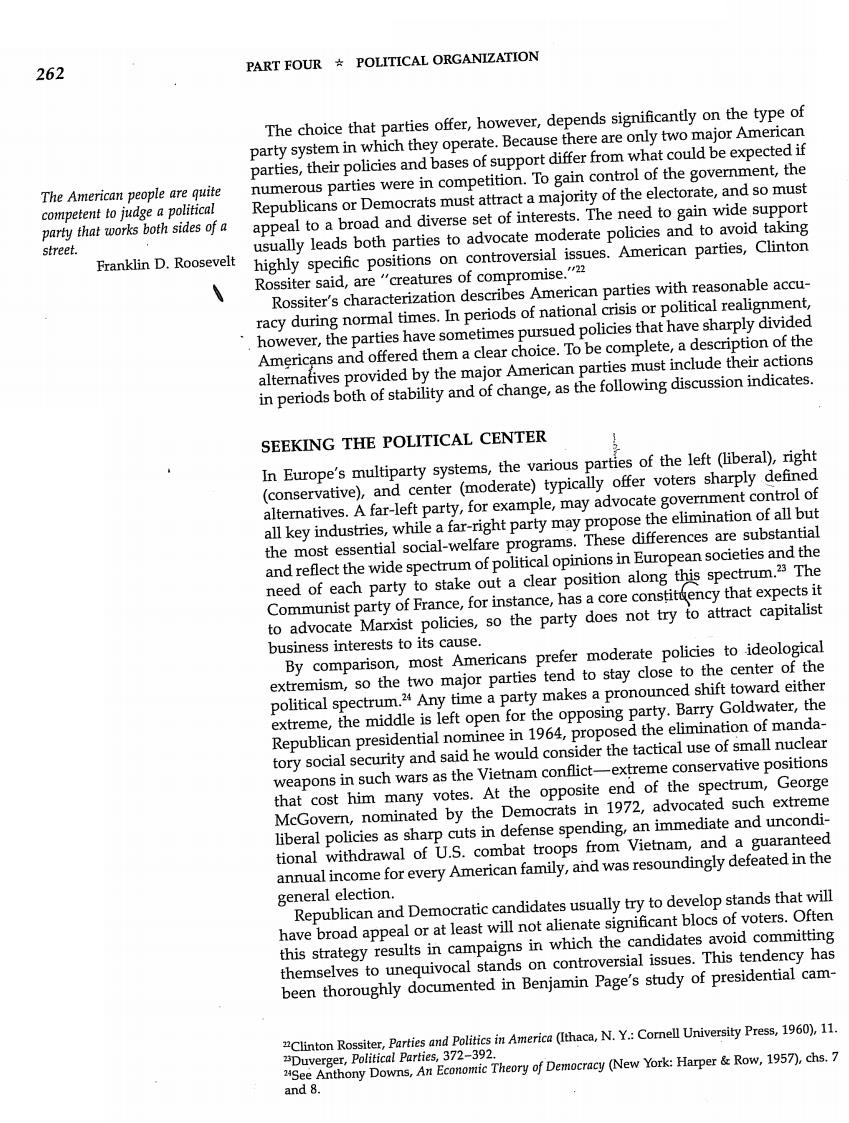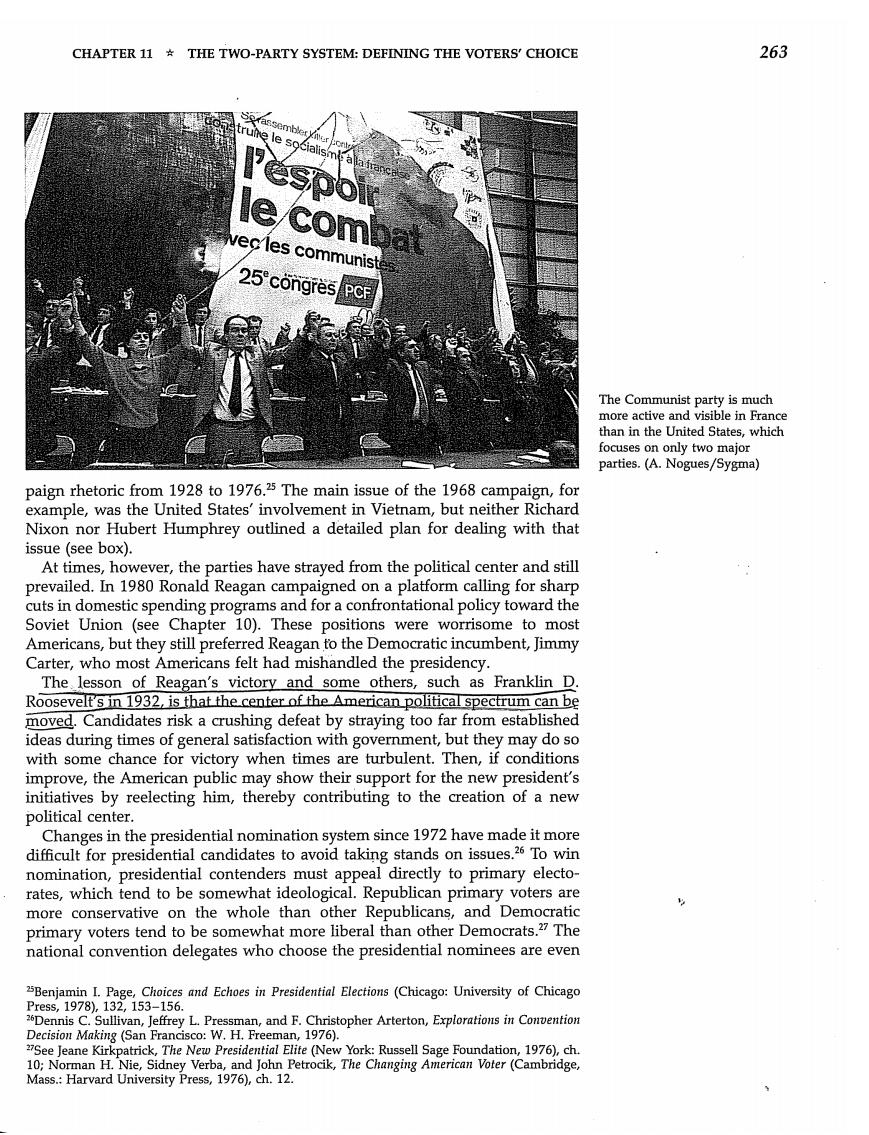
262 PART FOUR POLITICAL ORGANIZATION The choice that parties offer,however,depends significantly on the type of party system in which they operate.Because there are only two major American parties,their policies and bases of support differ from what could be expected if The American people are quite numerous parties were in competition.To gain control of the government,the competent to judge a political Republicans or Democrats must attract a majority of the electorate,and so must party that works both sides of a appeal to a broad and diverse set of interests.The need to gain wide support street. usually leads both parties to advocate moderate policies and to avoid taking Franklin D.Roosevelt highly specific positions on controversial issues.American parties,Clinton Rossiter said,are "creatures of compromise."22 Rossiter's characterization describes American parties with reasonable accu- racy during normal times.In periods of national crisis or political realignment, however,the parties have sometimes pursued policies that have sharply divided Americans and offered them a clear choice.To be complete,a description of the alternatives provided by the major American parties must include their actions in periods both of stability and of change,as the following discussion indicates SEEKING THE POLITICAL CENTER In Europe's multiparty systems,the various parties of the left (liberal),right (conservative),and center (moderate)typically offer voters sharply defined alternatives.A far-left party,for example,may advocate government control of all key industries,while a far-right party may propose the elimination of all but the most essential social-welfare programs.These differences are substantial and reflect the wide spectrum of political opinions in European societies and the need of each party to stake out a clear position along this spectrum.23 The Communist party of France,for instance,has a core constituency that expects it to advocate Marxist policies,so the party does not try to attract capitalist business interests to its cause. By comparison,most Americans prefer moderate policies to ideological extremism,so the two major parties tend to stay close to the center of the political spectrum.24 Any time a party makes a pronounced shift toward either extreme,the middle is left open for the opposing party.Barry Goldwater,the Republican presidential nominee in 1964,proposed the elimination of manda- tory social security and said he would consider the tactical use of small nuclear weapons in such wars as the Vietnam conflict-extreme conservative positions that cost him many votes.At the opposite end of the spectrum,George McGovern,nominated by the Democrats in 1972,advocated such extreme liberal policies as sharp cuts in defense spending,an immediate and uncondi- tional withdrawal of U.S.combat troops from Vietnam,and a guaranteed annual income for every American family,and was resoundingly defeated in the general election. Republican and Democratic candidates usually try to develop stands that will have broad appeal or at least will not alienate significant blocs of voters.Often this strategy results in campaigns in which the candidates avoid committing themselves to unequivocal stands on controversial issues.This tendency has been thoroughly documented in Benjamin Page's study of presidential cam- 2Clinton Rossiter,Parties and Politics in America(Ithaca,N.Y.:Cornell University Press,1960),11. Duverger,Political Parties,372-392. 2See Anthony Downs,An Economic Theory of Democracy (New York:Harper Row,1957),chs.7 and 8

CHAPTER 11 THE TWO-PARTY SYSTEM:DEFINING THE VOTERS'CHOICE 263 le comb vec les communist 25 congres Pea The Communist party is much more active and visible in France than in the United States,which focuses on only two major parties.(A.Nogues/Sygma) paign rhetoric from 1928 to 1976.25 The main issue of the 1968 campaign,for example,was the United States'involvement in Vietnam,but neither Richard Nixon nor Hubert Humphrey outlined a detailed plan for dealing with that issue (see box). At times,however,the parties have strayed from the political center and still prevailed.In 1980 Ronald Reagan campaigned on a platform calling for sharp cuts in domestic spending programs and for a confrontational policy toward the Soviet Union (see Chapter 10).These positions were worrisome to most Americans,but they still preferred Reagan to the Democratic incumbent,Jimmy Carter,who most Americans felt had mishandled the presidency. The lesson of Reagan's victory and some others,such as Franklin D. Roosevelt's in 1932,is that the center of the American political spectrum can be moved.Candidates risk a crushing defeat by straying too far from established ideas during times of general satisfaction with government,but they may do so with some chance for victory when times are turbulent.Then,if conditions improve,the American public may show their support for the new president's initiatives by reelecting him,thereby contributing to the creation of a new political center. Changes in the presidential nomination system since 1972 have made it more difficult for presidential candidates to avoid taking stands on issues.26 To win nomination,presidential contenders must appeal directly to primary electo- rates,which tend to be somewhat ideological.Republican primary voters are more conservative on the whole than other Republicans,and Democratic primary voters tend to be somewhat more liberal than other Democrats.27 The national convention delegates who choose the presidential nominees are even 2Benjamin I.Page,Choices and Echoes in Presidential Elections(Chicago:University of Chicago Press,1978),132,153-156. 2Dennis C.Sullivan,Jeffrey L.Pressman,and F.Christopher Arterton,Explorations in Convention Decision Making(San Francisco:W.H.Freeman,1976). 27See Jeane Kirkpatrick,The New Presidential Elite(New York:Russell Sage Foundation,1976),ch. 10;Norman H.Nie,Sidney Verba,and John Petrocik,The Changing American Voter(Cambridge, Mass.:Harvard University Press,1976),ch.12